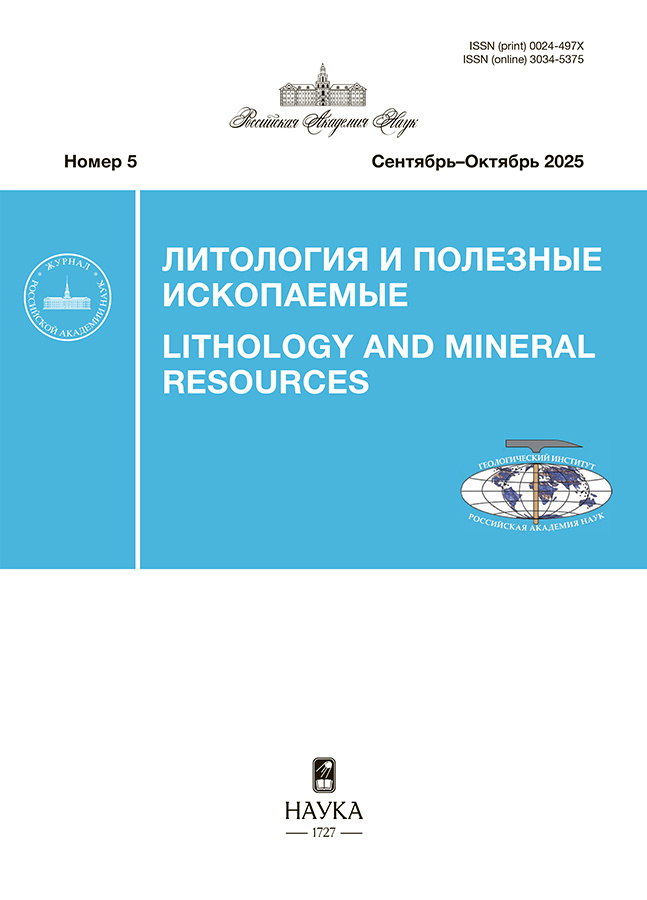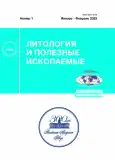Адсорбция катионов редкоземельных металлов полиметаллическими сульфидами гидротермальных полей Брокен Спур и ТАГ Атлантического океана
- Авторы: Новиков Г.В.1, Лобус Н.В.1, Шульга Н.А.1, Богданова О.Ю.1
-
Учреждения:
- Институт океанологии им. П.П. Ширшова РАН
- Выпуск: № 1 (2023)
- Страницы: 38-49
- Раздел: Статьи
- URL: https://journals.rcsi.science/0024-497X/article/view/137913
- DOI: https://doi.org/10.31857/S0024497X23010068
- EDN: https://elibrary.ru/GUIMDW
- ID: 137913
Цитировать
Полный текст
Аннотация
В статье приводятся результаты сорбции катионов редкоземельных металлов на образцах глубоководных полиметаллических сульфидов гидротермальных полей Брокен Спур и ТАГ Срединно-Атлантического хребта. Основными минералами этих образцов являлись соответственно марказит, пирротин, пирит, сфалерит и халькопирит, пирит, марказит. Установлено, что данные сульфидные минералы железа, меди и цинка являются природными адсорбентами. Обменная емкость сульфидных минералов по катионам редкоземельных металлов находится в диапазоне 0.006‒0.061 мг-экв/г. Обменный комплекс сульфидных минералов состоит из катионов щелочных, щелочноземельных металлов и основных катионов металлов кристаллической решетки – Fe, Zn, Cu (в очень ограниченном количестве). Механизм поглощения катионов редкоземельных металлов – ионообменный, эквивалентный относительно обменных катионов сульфидных минералов. Установлено, что в составе сульфидных минералов катионы редкоземельных металлов находятся практически полностью в сорбированной форме (более 90% от общего количества); химически связанная форма может быть, по-видимому, только для катионов Lu и Dy. В продуктах обменных реакций сохраняется минеральный состав сульфидных отложений, новые минеральные фазы не появляются.
Ключевые слова
Об авторах
Г. В. Новиков
Институт океанологии им. П.П. Ширшова РАН
Автор, ответственный за переписку.
Email: gvnovikov@yandex.ru
Россия, 117997, Москва, Нахимовский просп., 36
Н. В. Лобус
Институт океанологии им. П.П. Ширшова РАН
Email: gvnovikov@yandex.ru
Россия, 117997, Москва, Нахимовский просп., 36
Н. А. Шульга
Институт океанологии им. П.П. Ширшова РАН
Email: gvnovikov@yandex.ru
Россия, 117997, Москва, Нахимовский просп., 36
О. Ю. Богданова
Институт океанологии им. П.П. Ширшова РАН
Email: gvnovikov@yandex.ru
Россия, 117997, Москва, Нахимовский просп., 36
Список литературы
- Батурин Г.Н., Дмитриев Л.А., Дубинчук В.Т. и др. О составе сульфидных руд Восточно-Тихоокеанского поднятия (12°50′ с.ш.) // Геохимия. 1986. № 12. С. 1696‒ 1705.
- Батурин Г.Н., Дмитриев Л.А., Гурвич Е.Г. и др. Европиевая аномалия в сульфидных рудах океана // Докл. АН СССР. 1987. Т. 296. № 1. С. 207‒210.
- Бабаева С.Ф., Суханова А.А., Степанова Т.В. Редкоземельные элементы в массивных сульфидных рудах Срединно-Атлантического хребта (САХ) // Минералогия во всем пространстве сего слова // Материалы Годичного собрания Российского минералогического общества. СПб., 2014. С. 9‒11.
- Богданов Ю.А. Гидротермальные рудопроявления рифтов Срединно-Атлантического хребта. М.: Научный мир, 1997. 164 с.
- Богданов Ю.А., Сагалевич A.M., Гурвич Е.Г., Викентьев И.В., Леин А.Ю., Пименов Н.В., Пересып-кин В.И., Гордеев В.Ю., Войтов Д.В. Подводные геологические исследования гидротермального поля Рейнбоу (Срединно-Атлантический хребет) // Докл. РАН. 1999. Т. 365. № 5. С. 657‒662.
- Богданов Ю.А., Сагалевич А.М. Геологические исследования с глубоководных обитаемых аппаратов “Мир”. М.: Научный мир, 2002. 304 с.
- Бортников Н.С., Викентьев И.В. Современное сульфидное полиметаллическое минералообразование в Мировом океане // Геология рудных месторождений. 2005. № 1. С. 16‒50. (Bortnikov N.S., Vikent’ev I.V. Modern base metal sulfide mineral formation in the world ocean // Geology of Ore Deposits. 2005. V. 47(1). P. 13‒44)
- Викентьев И.В., Бонатти Э., Пейве А.А. Рудная минерализация в нормальном разрезе океанической коры (разломная зона Вима, 10°45′ с. ш. САХ) // Доклады Академии наук. 2000. Т. 375. № 4. С. 500‒503. (Vikent’ev I.V., Bonatti E., Peive A.A. Ore mineralization in the typical section of the oceanic crust, Vema Fracture Zone, 10°45′ N MAR // Doklady Earth Sciences. 2000. V. 375A. P. 1350‒1353)
- Гидротермальные сульфидные руды и металлоносные осадки океана. СПб.: Недра, 1992. 278 с.
- Леин А.Ю., Дара О.М., Богданова О.Ю., Новиков Г.В., Ульянова Н.В., Лисицын А.П. Источники микро- и редкоземельных элементов в гидротермальных постройках приконтинентальных рифтов с осадочным покровом (на примере впадины Гуаймас, Южный трог) // Океанология. 2018. Т. 58. № 2. С. 269‒284.
- Лурье Ю.Ю. Справочник по аналитической химии. М.: Химия, 1979. 480 с.
- Новиков Г.В., Шульга Н.А., Лобус Н.В., Богданова О.Ю. Адсорбция катионов тяжелых металлов полиметаллическими сульфидами гидротермальных полей Брокен Спур и ТАГ Атлантического океана // Литология и полез. ископаемые. 2020. Т. 55. № 1. С. 65‒74.
- Онуфриенок В.В. Анализ позиций примесных атомов в структуре пирита // Современные наукоемкие технологии. 2013. № 6. С. 186–193.
- Римская-Корсакова М.Н., Дубинин А.В. Редкоземельные элементы в сульфидах подводных гидротермальных источников Атлантического океана // Докл. РАН. 2003. Т. 389. № 5. С. 672‒676.
- Шульга Н.А., Пересыпкин В.И., Ревельский И.А. Изучение состава н-алканов в образцах гидротермальных отложений Срединно-Атлантического хребта с помощью метода газовой хроматографии/масс-спектрометрии // Океанология. 2010. Т. 50. № 4. С. 515–523.
- Bischoff J.L., Rosenbauer R.J., Aruscavage P.J. et al. Sea-floor massive sulfide deposits from 21° N East Pacific Rise, Juan de Fuca Ridge, and Galapagos Rift: Dulk chemical composithion and economic implications // Econ. Geol. 1983. V. 78(10). P. 1711‒1720.
- Fouquet Y., Auclair G., Cambon P., Etoubleau J. Geological setting and mineralogical and geochemical investigations on sulfide deposits near 13° N on the East Pacific Rise // Mar. Geol. 1988. V. 84(3–4). P. 145‒178.
- Haymon R.M., Koski R.A. The behavior of REEs in sea-floor hydrothermal systems: data from the Oman Ophiolite and the EPR Axis at 21 N // EOS. 1988. V. 69(44). P. 1489.
- Hannington M.D., De Ronde C.E.J., Petersen S. Sea-floor tectonics and submarine hydrothermal systems // Econ. Geol. 2005. V. 100. P. 111–141.
- Humphris S.E. Rare earth element composition of anhydrite: Implications for deposition and mobility within the active TAG hydrothermal mound // Proc. Ocean Drilling Program. Sci. Results. 1998. V. 158. P. 143‒159.
- Melekestseva I.Y., Maslennikov V.V., Tret’yakov G.A., Nimis P., Beltenev V.E., Rozhdestvenskaya I.I., Maslennikova S.P., Belogub E.V., Danyushevsky L.V., Large R.R., Yuminov A.M., Sadykov S.A. Gold- and silver-rich massive sulfides from the Semenov-2 hydrothermal field, 13°31.13′ N, Mid-Atlantic Ridge: a case of magmatic contribution? // Econ. Geol. 2017. V. 112. P. 741–773.
- Mills R.A., Elderfield H. Rare earth element geochemistry of hydrothermal deposits from the active TAG Mound. 26° N Mid-Atlantic Ridge // Ibid. 1995. V. 59(17). P. 3511‒3524.
- Monecke T., Petersen S., Hannington M.D., Grant H., Samson I.M. The minor element endowment of modern seafloor massive sulphides and comparison with deposits hosted in ancient volcanic successions // Rare Earth and Critical Elements in Ore Deposits / Eds P.L. Verplanck, M.W. Hitzman. Knoxville, TN, USA: Society of Economic Geologists, 2016. V. 18. P. 245–306.
- Morgan J.W., Wandless G.A. Rare earth element distribution in some hydrothermal elements: evidence for crystallographic control // Geochim. Cosmochim. Acta. 1980. V. 44. P. 973–980.
- Tauson V.L. Gold solubility in the common gold-bearing mi-nerals: experimental evaluation and application to pyrite // Eur. J. Miner. 1999. V. 11. № 6. P. 937–947.
- Vikentyev I., Vikent’eva O., Tyukova E., Nikolsky M., Ivanova J., Sidorova N., Tonkacheev D., Abramova V., Blokov V., Spirina A., Borisova D., Palyanova G. Noble metal speciations in hydrothermal sulphides // Minerals. 2021. № 11. P. 488. https://doi.org/10.3390/min11050488
Дополнительные файлы














